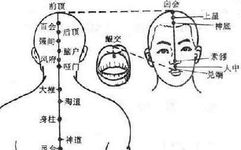1. Concept and Physiological Characteristics of the Eight Extraordinary Meridians
(1) Concept of the Eight Extraordinary Meridians
The Eight Extraordinary Meridians refer to eight meridians outside of the twelve primary meridians, including the Ren Mai (Ren Meridian), Du Mai (Du Meridian), Chong Mai (Chong Meridian), Dai Mai (Dai Meridian), Yin Qiao Mai (Yin Heel Meridian), Yang Qiao Mai (Yang Heel Meridian), Yin Wei Mai (Yin Linking Meridian), and Yang Wei Mai (Yang Linking Meridian). The term “extraordinary” (qi) indicates their distinct nature. Unlike the twelve primary meridians, they do not directly connect to the organs and do not have a paired relationship. Their physiological function mainly involves the storage and regulation of Qi and blood flow in the twelve primary meridians.
(2) Physiological Characteristics of the Eight Extraordinary Meridians
The physiological characteristics of the Eight Extraordinary Meridians are threefold: 1) The Eight Extraordinary Meridians do not have a direct connection to the organs. 2) There is no paired relationship among the Eight Extraordinary Meridians. 3) The distribution of the Eight Extraordinary Meridians is not as widespread as that of the twelve primary meridians; for instance, there are no distributions of the Eight Extraordinary Meridians in the upper limbs.
Moreover, their pathways differ from those of the twelve primary meridians, as all but the Dai Mai ascend from below to above.
The common physiological functions of the Eight Extraordinary Meridians are:
1. Further strengthening the connections between the twelve primary meridians: For example, the Du Mai governs all Yang meridians; the Ren Mai governs all Yin meridians; the Dai Mai restrains the longitudinal flow of various meridians. The two Qiao Mai govern the Yin and Yang of the body; the two Wei Mai connect the Yin and Yang of the body’s interior and exterior. Thus, the Eight Extraordinary Meridians enhance the connections among various parts of the body.
2. Regulating the Qi and blood of the twelve primary meridians: When the Qi of the twelve primary meridians is abundant, it is stored in the Eight Extraordinary Meridians; when the Qi and blood of the twelve primary meridians are insufficient, the Eight Extraordinary Meridians “overflow” to provide timely supplementation.
3. The Eight Extraordinary Meridians have a close relationship with the liver, kidneys, and other organs, as well as with the uterus, brain, and marrow, indicating a significant physiological and pathological connection among them.
2. Pathways and Physiological Functions of the Eight Extraordinary Meridians
(1) Pathway and Physiological Function of the Du Mai
1. Pathway: The Du Mai originates in the lower abdomen, exits at the perineum, travels posteriorly to the Changqiang point at the sacrococcygeal region, ascends along the spine, passes through the nape to the Fengfu point, enters the brain, belongs to the brain, follows the midline of the head, ascends to the Baihui point at the crown, descends through the forehead to the tip of the nose at the Suliao point, passes through the philtrum, and reaches the Gingjiao point at the center of the upper gums.
2. Branches: The first branch, originating with the Chong and Ren meridians from the uterus, exits at the perineum, and at the tailbone, it connects with the Foot Shaoyin Kidney Meridian and the Foot Taiyang Bladder Meridian, penetrating the spine and belonging to the kidneys. The second branch ascends directly from the lower abdomen through the navel, travels upward to the throat, where it meets the Chong and Ren meridians, and then encircles the lips, reaching the center below the eyes. The third branch, originating from the inner canthus of the Foot Taiyang Bladder Meridian, ascends to the forehead, intersects at the crown, connects to the brain, then descends from the nape, travels along the inner scapula, and reaches the lumbar region, entering the muscles on both sides of the spine, connecting with the kidneys.
3. Physiological Functions
(1) Regulates the Qi and blood of the Yang meridians, serving as the “sea of Yang meridians”: The Du Mai runs along the back, which is Yang, indicating its role in commanding and supervising the Qi of all Yang meridians. Additionally, all six Yang meridians intersect with the Du Mai at the Dazhui point, demonstrating its regulatory function over the Yang meridians, hence the saying “governs all Yang meridians in the body.”
(2) Reflects the functions of the brain, kidneys, and spinal cord: The Du Mai belongs to the brain and connects with the kidneys. The kidneys produce marrow, and the brain is considered the sea of marrow. The relationship between the Du Mai, brain, kidneys, and spinal cord is very close.
(3) Governs reproductive functions: The Du Mai connects with the kidneys, and since the kidneys govern reproduction, the Du Mai is related to reproductive functions.
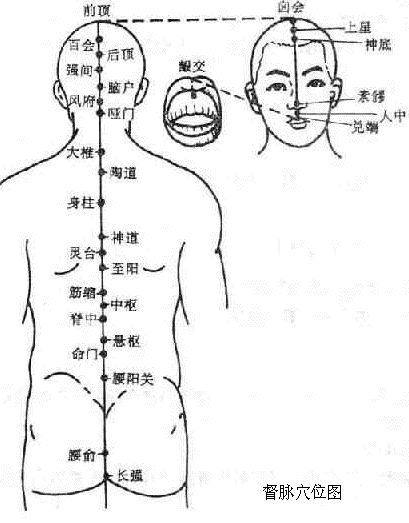

(2) Pathway and Physiological Function of the Ren Mai
1. Pathway: The Ren Mai originates in the uterus, exits at the perineum, travels through the Yin Palace, ascends along the midline of the abdomen, passes through the throat (Tiantu point), and reaches the inner lower lip, where it divides to encircle the lips, meeting at the Gingjiao point of the Du Mai, and then separately travels through both sides of the nostrils, ascending to the lower eye socket (Chengqi point), where it intersects with the Foot Yangming Meridian.
2. Branches: It penetrates the spine from the uterus, ascending along the back.
3. Physiological Functions
(1) Regulates the Qi and blood of the Yin meridians, serving as the “sea of Yin meridians”: The Ren Mai runs along the midline of the abdomen, which is Yin, indicating its role in overseeing and managing the Qi of all Yin meridians. Additionally, the three Yin meridians of the foot intersect with the Ren Mai in the lower abdomen, and the three Yin meridians of the hand connect with the Ren Mai through the three Yin meridians of the foot, thus the Ren Mai regulates the Qi and blood of the Yin meridians, hence the saying “governs all Yin meridians.”
(2) Regulates menstruation and nourishes the fetus: The Ren Mai originates in the uterus, playing a role in regulating menstruation and promoting female reproductive functions, hence the saying “the Ren governs the uterus and fetus.”
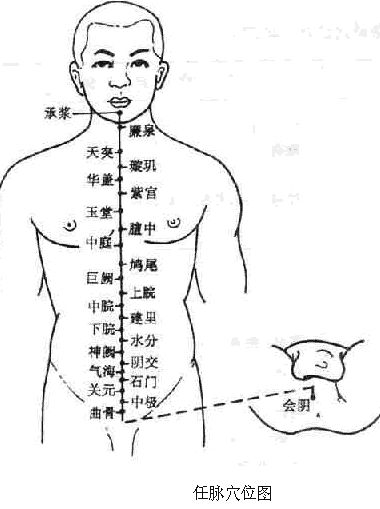
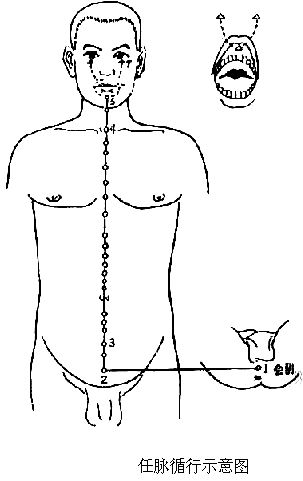
(3) Pathway and Physiological Function of the Chong Mai
1. Pathway: The Chong Mai originates in the uterus, exits at the perineum, and divides into two branches. The ascending branch (the main trunk of the Chong Mai) runs along the anterior abdominal wall, near the navel (five fen from the navel), ascends, parallels the Foot Shaoyin Meridian, spreads in the chest, then ascends through the throat, encircling the lips; the descending branch runs along the posterior abdominal wall, ascending within the spine. The descending branch exits the perineum, travels down the inner thigh to the space between the big toe.
2. Physiological Functions
(1) Regulates the Qi and blood of the twelve primary meridians: The Chong Mai ascends to the head and descends to the feet, traversing the entire body, serving as a crucial conduit for the Qi and blood of all meridians. When the Qi and blood of the meridians and organs are abundant, the Chong Mai can store and reserve them; when they are insufficient, the Chong Mai can provide infusion and supplementation to maintain the normal physiological activities of the body’s tissues and organs. Thus, it is referred to as the “sea of the twelve meridians,” the “sea of the five organs and six bowels,” and the “sea of blood.”
(2) Governs reproductive functions: The Chong Mai originates in the uterus, also known as the “blood chamber” or “blood sea.” The Chong Mai plays a role in regulating menstruation. It is closely related to reproductive functions; for instance, when the “Tai Chong Mai” is abundant, menstruation occurs regularly, leading to conception. Conversely, if the “Tai Chong Mai” is deficient, it can lead to reproductive dysfunction.
(3) Regulates the ascending and descending of Qi: The Chong Mai, during its pathway, connects with the Foot Shaoyin, belongs to the Yangming, and communicates with the Jueyin and Taiyang. The Chong Mai has the function of regulating the ascending and descending of Qi in certain organs (mainly the liver, kidneys, and stomach).
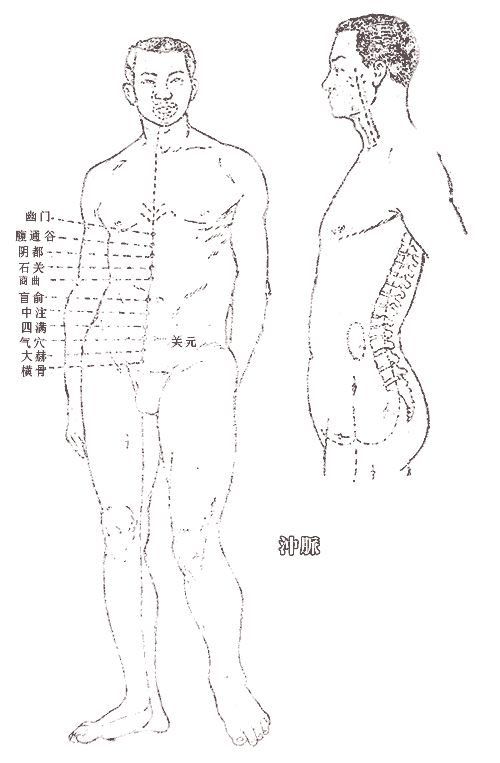
(4) Pathway and Physiological Function of the Dai Mai
1. Pathway: The Dai Mai originates at the lateral costal region, descending obliquely, intersecting at the Dai Mai point of the Foot Shaoyang Gallbladder Meridian, encircling the body, and at the Dai Mai point, it further descends obliquely along the upper edge of the hip bone to the lower abdomen.
2. Physiological Functions: It restrains the longitudinal flow of various meridians and governs the discharge in women.
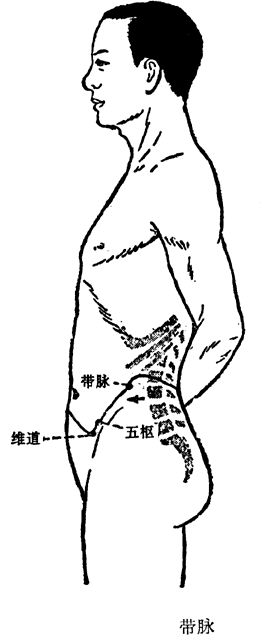
(5) Pathway and Physiological Function of the Yin Qiao Mai
1. Pathway: The Yin Qiao Mai originates at the inner side of the heel from the Zhaohai point of the Foot Shaoyin Meridian, ascends through the inner ankle, travels along the inner side of the thigh to the anterior genital area, ascends along the anterior surface of the trunk to the chest, enters the Qiaoyin point, ascends beside the Adam’s apple to the Ren Mai’s Renying point, reaches beside the nose, and connects with the inner canthus, ascending with the Foot Taiyang and Yang Qiao Mai.
2. Physiological Functions: It controls the opening and closing of the eyes and the movement of the muscles.

(6) Pathway and Physiological Function of the Yang Qiao Mai
1. Pathway: The Yang Qiao Mai originates at the outer side of the heel from the Shenmai point of the Foot Taiyang Meridian, ascends along the posterior edge of the outer ankle, travels up the outer side of the lower limb to the abdomen, along the posterior outer side of the chest, through the shoulder, neck, and up to the corner of the mouth, reaching the inner canthus. It connects with the Foot Taiyang and Yin Qiao Mai, then ascends along the Foot Taiyang Meridian to meet the Foot Shaoyang Meridian at the Fengchi point behind the neck.
2. Physiological Functions: It controls the opening and closing of the eyes and muscle movement.

(7) Pathway and Physiological Function of the Yin Wei Mai
1. Pathway: The Yin Wei Mai originates at the Zhubin point, five cun above the inner ankle of the Foot Shaoyin Meridian, ascends along the posterior edge of the inner side of the lower limb to the abdomen, travels alongside the Foot Taiyin Spleen Meridian to the lateral costal region, intersects with the Foot Jueyin Liver Meridian, ascends to meet the Tian Tu point of the Ren Mai, and terminates at the Lianquan point in the throat.
2. Physiological Functions: The term “Wei” in Wei Mai means to connect and link. The Yin Wei Mai serves to connect the Yin meridians.

(8) Pathway and Physiological Function of the Yang Wei Mai
1. Pathway: The Yang Wei Mai originates at the Jimen point of the Foot Taiyang Meridian, passes over the outer ankle, ascends along the posterior edge of the outer lower limb, travels through the posterior outer side of the trunk, from the back of the armpit to the shoulder, through the neck, behind the ear, and forward to the forehead, distributing along the side of the head and back of the neck, connecting with the Du Mai.
2. Physiological Functions: It connects the Yang meridians.

For those who are parents, not knowing medicine is unkind; for those who are children, not knowing medicine is unfilial.

